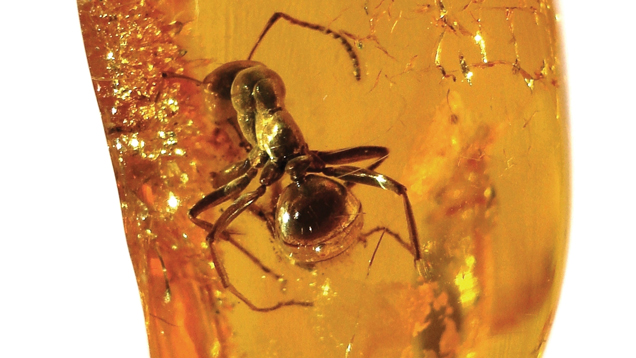Scientific Adventures: Amber preserves 99 million-year-old lizard
 CREDIT: ANDERS L. DAMGAARD
CREDIT: ANDERS L. DAMGAARDAmber containing mosquitoes is the premise for Jurassic Park, but this piece of Baltic Amber instead holds an ancient ant.
Lizards in amber are oldest found
A team of herpetologists who were recently allowed to study private collections of amber at the American Museum of Natural History have discovered the oldest known preserved lizards ever found.
By using uranium-lead radiometric dating, one of the most accurate ways to find an ancient object’s age, the team measured sediments trapped within amber collected at the same time as the 12 specimens, ranging from complete lizards, up to several centimeters in length, to limbs of geckos that still retain their characteristic wall climbing toe pads.
The radiometric dating measured one of the reptiles, a tiny one-centimeter long ancestor to the chameleon, back to the late Cretaceous period of the Mesozoic Era at 99 million years old. All of the amber- enclosed lizards were found in a Myanmar mine.
Using high-resolution x-ray computer tomography (CT) scanning technology, the researchers were able to record accurate depictions of the reptiles through the amber without having to cut or damage the specimen.
The team was able to capture images of the skeletons with teeth still intact, delicate eye bones and even internal organs still preserved by the golden time machine.
Amber is the fossilized remains of tree resin, which is then covered in layers of sediments and subjected to the same geological forces as the animals and plants that we today know as fossils.
The semi-translucent material has held significance to humans for millennia, with the oldest known archaeological find dating to over 13,000 years ago.
Amber is an extremely important scientific tool for palaeontologists and evolutionary biologists, as it captures tiny snapshots of everyday life from millions of years ago, preserving it while allowing the study of species who would normally be lost from the fossil record due to their fragile biology.
In fact, the researchers stated the find was important for establishing calibration points on the evolutionary timescale of lizards.
Previous finds inside amber have included feathers suspected to be from dinosaurs, spiders and numerous plant species.
While the lizards dated back to 99 million years old, it’s certainly not the oldest creature found in amber deposits. That title goes to a pair of mites found in 2012, which date over 230 million years old.
Stem cells fixing damaged eyes
A duo of studies performed by separate research teams from around the world are looking to improve the lives of those suffering from eyesight issues due to ocular damage and cataracts, with one of the studies specifically looking to help infants and toddlers.
In a study by Welsh and Japanese researchers, different types of ocular tissues could be regrown with some startling results.
The teams used induced pluripotent stem cells (iPSC) of humans, reprogramming then to begin growing corneal, or eye tissue in petri dishes.
These cells are created by taking cells of a creature, such as epithelial skin cells, and through a series of biochemical processes, causing them to revert to an early state called stem cells. At this point, the cells can be reprogrammed into the wanted type through another series of biochemical processes.
The petri dish experiments began to grow in a bulls-eye fashion, with cells differentiating into different types of tissues observed in the eye, including the cells relating to the optic nerve, lens and corneal epithelium.
The team called the ocular cells growing into an eye-like structure for Self-formed Ectodermal Autonomous Multizone (SEAM). The corneal epithelium, or outermost layer of the eye is what the researchers were originally trying to grow.
The researchers were able to remove the corneal cells from the test dishes and implant them into rabbits that were blind due to corneal tissue damage. The graft of new corneal cells was able to heal fully and allowed the rabbits to regain sight.
While several types of eye tissues were grown, only the corneal tissue was transplanted. The team is now looking at more accurately growing and differentiating these tissues while looking at how to replace damaged regions of the eye with the newly grown healthy cells.
The second study, performed by American and Chinese researcher used human stem cells to induce the eye to fix itself.
The researchers used mouse studies as well as infants who were born with cataracts, placing them into two test groups.
In the first group they performed the usual cataract surgery, where the lens of the eye is removed, being replaced with an artificial plastic version.
The second group had the new procedure performed, where the stem cells within the eye were induced to begin growing a new organic lens.
Continued observations showed that at three months the eyes had begun to regrow a lens by themselves, while at the six-month mark the lenses were thicker, continuing to repair themselves.
While the cataract is still removed in a similar way to current practices, the new procedure differed in that it tried to preserve the stem cells within the eye, not remove them, and instead used them to fix the eye.
A complication from cataract surgery, a second surgery is sometimes needed to remove the stem cells left in the eye that have attached themselves to the new artificial lens, which can cause vision problems.
The new procedure allows those stem cells to instead let the eye begin re-growing its own lens.
The study is important because this is a major source of complication in cataract surgery that can sometimes lead the patient to suffer from worse vision than before they had their cataract removed.
Next week we’ll take a look at a recent experiment into regulating genes that induced some prehistoric features into embryonic chickens.














